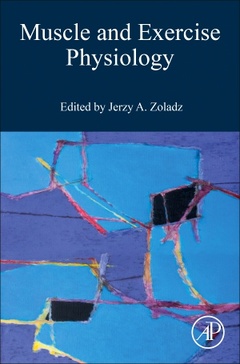Description
Muscle and Exercise Physiology
Coordinator: Zoladz Jerzy A.
Language: English
Subject for Muscle and Exercise Physiology:
Keywords
31P magnetic resonance spectroscopy; ATP turnover; Acceleration/deceleration; Actin; Activation metabolism; Afferent neurons; Air resistance; Anticancer; Antioxidant damage-repair systems; Athlete; Basal metabolic rate; Basal metabolism; Bioactive sphingolipids; Bioenergetics; Blood pressure; Blood-myocyte oxygen flux; Bone strengthening; CHO metabolism; Carbohydrate; Cardiac energy conversion; Cardiac muscle cell; Chronic heart failure; Contractile activity; Contractile proteins; Contraction; Coronary blood flow; Coronary circulation; Coupling; Critical power; Cycling; Dynamic exercise; Endogenous CHO availability; Endurance; Endurance exercise; Energy cost; Excitation-contraction coupling; Exercise; Exercise hyperemia; Exercise intensity; Exercise parameters; Exercise pressor reflex; Exercise training; Exercise type; Exogenous CHO availability; Fall risk; Fall-impact reduction; Fast and slow muscles; Fatty acid transporters; Fiber atrophy; Fick's law; Force capacity; Force generation; Force transmission; Functional features of the motor unit; Gap junction; Glycogenolysis; Heart rate; Human locomotion; Intramuscular lipid metabolism; Lactate threshold; Loading state; Locomotor system; Mechanical activity; Metabolism; Microvascular; Mitochondria; Mitochondrial biogenesis; Mitochondrial efficiency; Motoneurons; Motor neuron loss; Motor unit; Motor units; Muscle ageing; Muscle biochemistry; Muscle energetics; Muscle fatigability; Muscle fatigue; Muscle fiber loss; Muscle fibers; Muscle function; Muscle glycogen; Muscle lipids; Muscle mass; Muscle spindles; Muscular exhaustion; Myocyte shortening; Myokines; Myosin; Myosin molecule; Neural control; Neuromuscular determinants; Noninvasive methods; Osteoporosis; Oxidative damage-repair systems; Oxygen uptake kinetics; PH; Peptides; Performance; Perfusion; Power-duration relationship
618 p. · 21.4x27.6 cm · Hardback
Description
/li>Contents
/li>Readership
/li>Biography
/li>Comment
/li>
Muscle and Exercise Physiology is a comprehensive reference covering muscle and exercise physiology, from basic science to advanced knowledge, including muscle power generating capabilities, muscle energetics, fatigue, aging and the cardio-respiratory system in exercise performance. Topics presented include the clinical importance of body responses to physical exercise, including its impact on oxygen species production, body immune system, lipid and carbohydrate metabolism, cardiac energetics and its functional reserves, and the health-related effects of physical activity and inactivity. Novel topics like critical power, ROS and muscle, and heart muscle physiology are explored.
This book is ideal for researchers and scientists interested in muscle and exercise physiology, as well as students in the biological sciences, including medicine, human movements and sport sciences.
Skeletal Muscle Morphology 1. Human Body Composition and Muscle Mass 2. Functional Morphology of the Striated Muscle 3. Mechanisms of Muscle Contraction and Relaxation 4. Motor Units and Muscle Receptors
Muscle Energetics and its Performance 5. Muscle Energetics 6. Efficiency of Skeletal Muscle 7. Muscle Function: Strength, Speed, and, Fatigability 8. Critical Power: Possibly the Most Important Fatigue Threshold in Exercise Physiology 9. Energy Cost of Human Locomotion on Land and in Water
Muscle Metabolism and Exercise Physiology 10. The Coupling of Internal and External Gas Exchange During Exercise 11. Carbohydrate Metabolism During Exercise 12. Muscle Lipid Metabolism 13. Muscle as an Endocrine Organ 14. The Role of Reactive Oxygen and Nitrogen Species in Skeletal Muscle 15. Exercise, Immunity and Illness
Body Adaptation to Exercise 16. The Evolution of Skeletal Muscle Plasticity in Response to Physical Activity and Inactivity 17. Muscle Blood Flow and Vascularization in Response to Exercise and Training 18. Metabolic Transitions and Muscle Metabolic Stability: Effects of Exercise Training 19. Human Aging - Impact on Muscle Force and Power 20. The Role of Exercise on Fracture Reduction and Bone Strengthening
Heart Muscle and Exercise 21. Functional Morphology of the Cardiac Myocyte 22. Exercise and the Coronary Circulation 23. Cardiac Energetics 24. Regulation of Heart Rate and Blood Pressure During Exercise in Humans 25. Sympatho-excitation in Heart Failure: Contribution of Skeletal Muscle Reflexes and the Protective Role of Exercise Training
Researchers and scientists interested in muscle and exercise physiology as well as students of biological sciences, including medicine, human movements and sport sciences.
- Contains basic and state-of-the-art knowledge on the most important issues of muscle and exercise physiology, including muscle and body adaptation to physical training, the impact of aging and physical activity/inactivity
- Provides both the basic and advanced knowledge required to understand mechanisms that limit physical capacity in both untrained people and top class athletes
- Covers advanced content on muscle power generating capabilities, muscle energetics, fatigue and aging
These books may interest you

Nutrition and Skeletal Muscle 146.54 €



